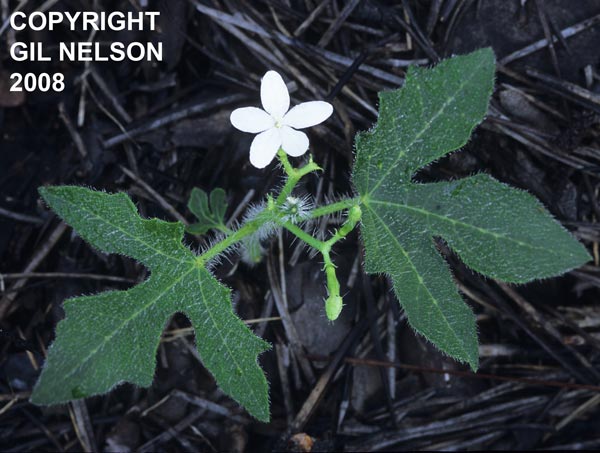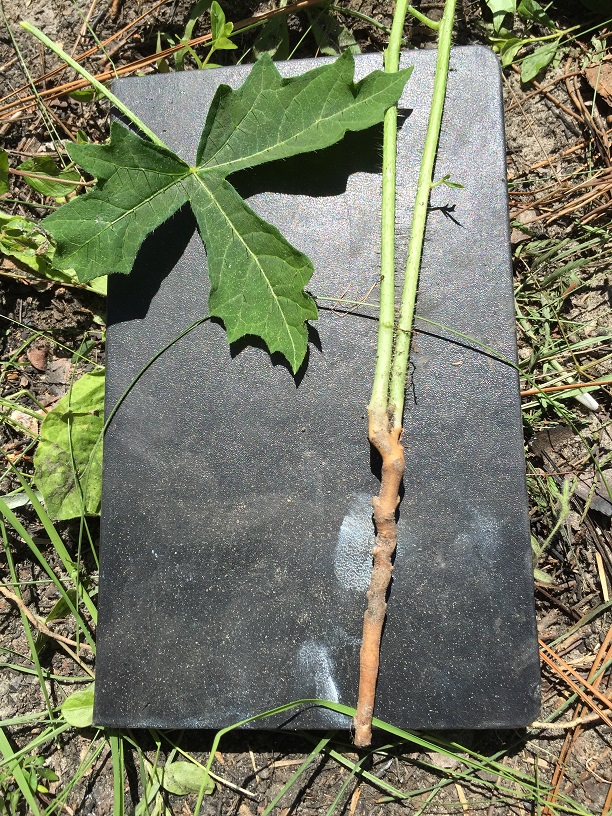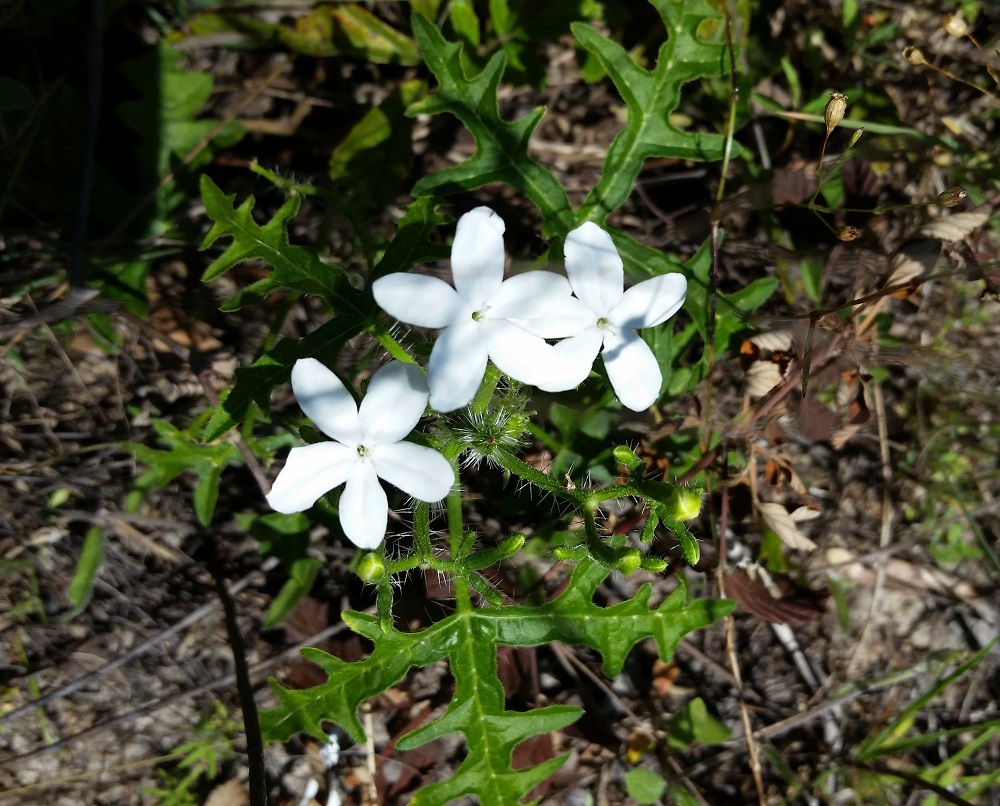Difference between revisions of "Cnidoscolus stimulosus"
(→Ecology) |
(→Seed dispersal) |
||
| Line 46: | Line 46: | ||
===Seed dispersal=== | ===Seed dispersal=== | ||
| − | “In all of these species, seeds are forcefully expelled after the fruit matures and dries. Three of the ballistic euphorbs (''C. stimulosus'', ''C. argyranthemus'' and ''S. sylvatica'') produce seeds with elaiosomes and all of the ballistic species are collected by ants, in particular ''Pogonomyrex badius'' Latreille (Long and Lakela 1971; N.E. Stamp and J. R. Lucas, personal observation).” <ref name="Stamp and Lucas 1990"/> This species is thought to be dispersed by ants and/or explosive dehiscence. <ref>Kirkman, L. Katherine. Unpublished database of seed dispersal mode of plants found in Coastal Plain longleaf pine-grasslands of the Jones Ecological Research Center, Georgia.</ref> | + | “In all of these species, seeds are forcefully expelled after the fruit matures and dries. Three of the ballistic euphorbs (''C. stimulosus'', ''C. argyranthemus'' and ''S. sylvatica'') produce seeds with elaiosomes and all of the ballistic species are collected by ants, in particular ''Pogonomyrex badius'' Latreille (Long and Lakela 1971; N.E. Stamp and J. R. Lucas, personal observation).” <ref name="Stamp and Lucas 1990"/> This species is thought to be dispersed by ants and/or explosive dehiscence. <ref>Kirkman, L. Katherine. Unpublished database of seed dispersal mode of plants found in Coastal Plain longleaf pine-grasslands of the Jones Ecological Research Center, Georgia.</ref> The ant preference for ''C. stimulosus'' might be due to the elaiosome and its chemical composition.<ref name= "Cumberland">Cumberland, M. S. and L. K. Kirkman (2013). "The effects of the red imported fire ant on seed fate in the longleaf pine ecosystem." Plant Ecology 214: 717-724.</ref> |
<!--===Seed bank and germination===--> | <!--===Seed bank and germination===--> | ||
Revision as of 14:56, 8 April 2019
| Cnidoscolus stimulosus | |
|---|---|

| |
| Scientific classification | |
| Kingdom: | Plantae |
| Division: | Magnoliophyta - Flowering plants |
| Class: | Magnoliopsida – Dicotyledons |
| Order: | Euphorbiales |
| Family: | Euphorbiaceae |
| Genus: | Cnidoscolus |
| Species: | C. stimulosus |
| Binomial name | |
| Cnidoscolus stimulosus (Michx.) Govaerts | |

| |
| Natural range of Cnidoscolus stimulosus from USDA NRCS Plants Database. | |
Common names: Finger-rot; Spurge-nettle; Tread-softly; Bull-nettle
Contents
Taxonomic notes
Synonyms: Cnidoscolus urens (Linnaeus) Arthur var. stimulosus (Michaux) Govaerts; Bivonea stimulosa (Michaux) Rafinesque
Varieties: none
Description
Cnidoscolus stimulosus is a perennial herbaceous species. It tends to grow erect from a tuberous base, and is marked by the presence of urticating hairs.[1]
Cnidoscolus stimulosus is a herbaceous, monoecious, erect or reclining perennial, growing 0.5-10 dm tall with palmately dissected or lobed, alternate leaves. The entire plant is covered with stinging trichomes. The leaf lobes or dissections lobed or prominently dentate, very rarely entire. The inflorescence is terminal, compound, dichasial cyme, often appearing axillary because of the elongation of axillary branches with terminal inflorescence. The central flower in each dischasium is uaully pistillate, the lateral is usually staminate. The calyx is white in color, salverform, the tube grows 1-1.5 cm long, equaling or almost equalling the lobes. The petals are absent. There are 10-30 stamens, united at the base. There are 3 stigmas, each with 3-5 lobes. The capsule is 3-locular, each locule is 1-seeded. The seeds are dark-brown in color, growing 8-9 mm long, and 4-5 mm broad, with a conspicuous caruncle at the base.[2]
Distribution
C. stimulosus is native to the southeast Coastal Plain in the United States, ranging from Kentucky and Virginia south to Louisiana and Florida, excluding Arkansas and Tennessee.[3] Although this species is sometimes treated as a variety of C. urens, C. stimulosus has a different distribution than C. urens, which ranges from Mexico and Central America south to northern South America.[4]
Ecology
Habitat
Cnidoscolus stimulosus is found in sparsely canopied upland habitats that occur on deep, well drained, sandy substrate suitable for construction of Gopher tortoise burrows. It also occurs in dry sandy flatwoods,[5] sandy barrens, mixed hardwood hammocks, sand dunes, longleaf pine-wiregrass-scrub oak sand ridges,[1] and mesic longleaf pine savannas.[6] Cnidoscolus stimulosus is a feature of sandhill communities with frequent occurrence in the understory.[7] Finally, it occurs in some disturbed areas, such as roadsides, old fields, bulldozed clearings, railways, and residential lawns.[1]
Phenology
It has three seeds fruit and produce seeds with elaiosomes.[7]
C. stimulosus has been observed flowering January through August, October and December with peak inflorescence in April.[8][1] Fruiting was observed April through August and in December.
This species has been observed to flower within three months following burning.[9] It has also been shown to have peak production (including flowering) on double-disked plots on the second year of study.[10]
Seed dispersal
“In all of these species, seeds are forcefully expelled after the fruit matures and dries. Three of the ballistic euphorbs (C. stimulosus, C. argyranthemus and S. sylvatica) produce seeds with elaiosomes and all of the ballistic species are collected by ants, in particular Pogonomyrex badius Latreille (Long and Lakela 1971; N.E. Stamp and J. R. Lucas, personal observation).” [7] This species is thought to be dispersed by ants and/or explosive dehiscence. [11] The ant preference for C. stimulosus might be due to the elaiosome and its chemical composition.[12]
Fire ecology
It is included in the flowering plant survery – post burn – in Heuberger’s study.[13] Cnidoscolus stimulosus was one of the plant species to increase in abundance recovery post-fire in Rosemary scrub ecosystem.[14] Cnidoscolus stimulosus also resprouted post-burn after fire was reinstated into the ecosystem.[15]
It resprouts and flowers within two months of burning in the growing season.KMR In southeastern Polk County, C. stimulosus was observed blooming 54 days after a prescribed burn on December 22, 2016.[6] Similarly, in Charlotte County, FL, it was observed blooming about 19 days post burn.[16] Overall, the species appears to be tolerant of fire, and potentially benefits from it, but it does not seem to be dependent on the presence of fire on the landscape.[1]
Use by animals
Seeds were found in middens of harvester-ant nests of Pogonomyremex badius Latreille. In addition, seeds of all three plant species were observed being carried into the ant nests and then later deposited uneaten at the nest perimeter.[7] Gopher tortoises (juveniles and adults) feed on Cnidoscolus stimulosus. Included in gopher tortoises’ scat.[17] It consists of approximately 2-5% of the diet for terrestrial birds.[18]
Diseases and parasites
C. stimulosus is a host plant for the false spider mite (Brevipalpus obovatus) in North America.[19]
Conservation and management
Cultivation and restoration
Photo Gallery
References and notes
- ↑ 1.0 1.1 1.2 1.3 1.4 Florida State University Robert K. Godfrey Herbarium database. URL: http://herbarium.bio.fsu.edu. Last accessed: June 2014. Collectors: H. E. Ahles, L. C. Anderson, W. R. Anderson, L. Baltzell, D. Burch, K. C. Burks, R. J. Campana, J. Carmichael, A. F. Clewell, D. Demaree, F. S. Earle, P. Elliot, D. L. Fichtner, T. Floyd, E. Freeman, W. B. Fox, H. Gale, M. A. Garland, H. E. Grelen, W. T. Gillis, R. K. Godfrey, J. Haesloop, B. K. Holst, C. Hudson, P. Jones, W. Kittredge, G. R. Knight, R. Komarek, R. Kral, D. W. Mather, S. McDaniel, R. S. Mitchell, S. J. Noyes, K. Oakes, G. W. Ramsey, G. W. Reinert, A. B. Seymour, D. B. Ward, J. H. Wiese, and R. L. Wilbur. States and Counties: Alabama: Geneva. Florida: Alachua, Bay, Broward, Calhoun, Citrus, Dade, Franklin, Gadsden, Hernando, Jackson, Jefferson, Lake, Leon, Liberty, Madison, Marion, Monroe, Nassau, Okaloosa, Orange, Pasco, Pinellas, Sarasota, Suwannee, and Wakulla. Georgia: Bullock, Grady, and Thomas. Mississippi: near Ocean Springs, George, and Forrest. North Carolina: Carteret, Cleveland, Cumberland, Duplin, Harnett, Hertford, and Pender.
- ↑ Radford, Albert E., Harry E. Ahles, and C. Ritchie Bell. Manual of the Vascular Flora of the Carolinas. 1964, 1968. The University of North Carolina Press. 661-2. Print.
- ↑ USDA, NRCS. (2016). The PLANTS Database (http://plants.usda.gov, 8 April 2019). National Plant Data Team, Greensboro, NC 27401-4901 USA.
- ↑ Weakley, A. S. (2015). Flora of the Southern and Mid-Atlantic States. Chapel Hill, NC, University of North Carolina Herbarium.
- ↑ Glitzenstein, J. S., D. R. Streng, et al. (2003). [Abstract] Long-term seasonal burning at the St. Marks National Wildlife Refuge, north Florida: changes in the sandhill plots after 23 years. Second International Wildland Fire Ecology and Fire Management Congress and Fifth Symposium on Fire and Forest Meteorology, Orlando, FL, American Meteorological Society.
- ↑ 6.0 6.1 Observation by Edwin Bridges in southeastern Polk County, FL, February 14, 2017, posted to Florida Flora and Ecosystematics Facebook Group February 15, 2017.
- ↑ 7.0 7.1 7.2 7.3 Stamp, N. E. and J. R. Lucas (1990). "Spatial patterns and dispersal distances of explosively dispersing plants in Florida sandhill vegetation." Journal of Ecology 78: 589-600.
- ↑ Nelson, G. PanFlora: Plant data for the eastern United States with emphasis on the Southeastern Coastal Plains, Florida, and the Florida Panhandle. www.gilnelson.com/PanFlora/ Accessed: 7 DEC 2016
- ↑ Kevin Robertson personal observation at Pebble Hill Plantation, Georgia and Tall Timbers Research Station, Florida, July 2015.
- ↑ Buckner, J. L. and J. L. Landers (1979). "Fire and disking effects on herbaceous food plants and seed supplies." Journal of Wildlife Management 43: 807-811.
- ↑ Kirkman, L. Katherine. Unpublished database of seed dispersal mode of plants found in Coastal Plain longleaf pine-grasslands of the Jones Ecological Research Center, Georgia.
- ↑ Cumberland, M. S. and L. K. Kirkman (2013). "The effects of the red imported fire ant on seed fate in the longleaf pine ecosystem." Plant Ecology 214: 717-724.
- ↑ Heuberger, K. A. and F. E. Putz (2003). "Fire in the suburbs: ecological impacts of prescribed fire in small remnants of longleaf pine (Pinus palustris) sandhill." Restoration Ecology 11: 72-81.
- ↑ Menges, E. S. and N. M. Kohfeldt (1995). "Life History Strategies of Florida Scrub Plants in Relation to Fire." Bulletin of the Torrey Botanical Club 122(4): 282-297.
- ↑ Reinhart, K. O. and E. S. Menges (2004). "Effects of re-introducing fire to a central Florida sandhill community." Applied Vegetation Science 7: 141-150.
- ↑ Observation by Jake Antonio Heaton in Charlotte County, FL, May 22, 2016, posted to Florida Flora and Ecosystematics Facebook Group May 23, 2016.
- ↑ Birkhead, R. D., C. Guyer, et al. (2005). "Patterns of folivory and seed ingestion by gopher tortoises (Gopherus polyphemus) in a southeastern pine savanna." American Midland Naturalist 154: 143-151
- ↑ Miller, J.H., and K.V. Miller. 1999. Forest plants of the southeast and their wildlife uses. Southern Weed Science Society.
- ↑ Childers, C. C., et al. (2003). "Host plants of Brevipalpus californicus, B. obovatus, and B. phoenicis (Acari: Tenuipalpidae) and their potential involvement in the spread of viral diseases vectored by these mites." Experimental & Applied Acarology 30: 29-105.

